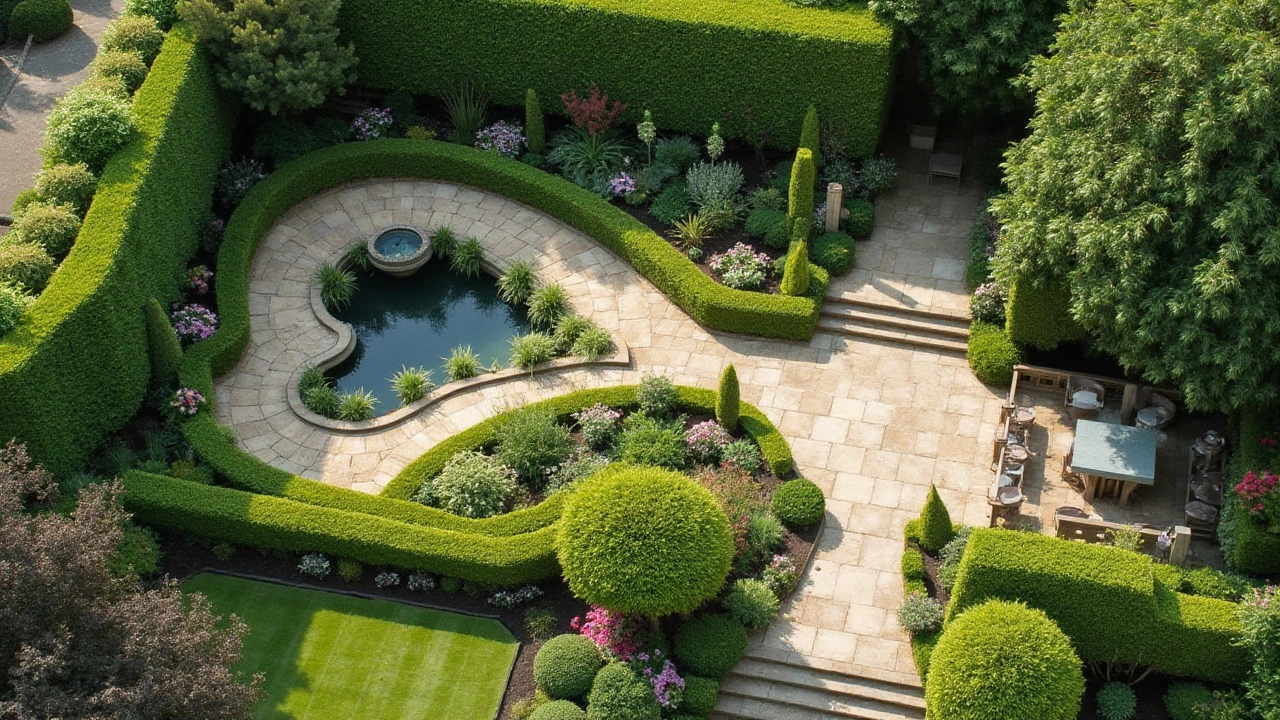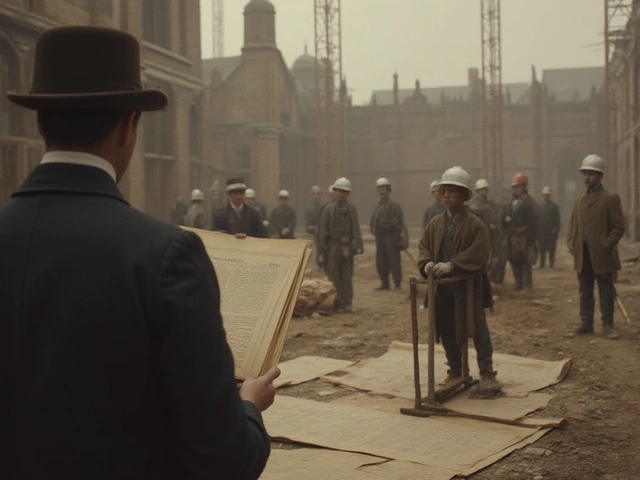Embarking on a landscaping project can be both an exciting and daunting venture. Whether you're dreaming of a lush green garden or a sleek modern yard, one of the key considerations is budgeting, as costs can escalate quickly without proper planning.
This guide simplifies the myriad of factors that influence landscaping costs, helping you craft a realistic budget while ensuring a stunning result.
From selecting materials to understanding labor charges, each element plays a vital role in shaping the final expenses. Delve into the insights and equip yourself with the knowledge to make informed decisions for turning your outdoor space into a personal paradise.
- Understanding the Scope of Your Project
- Choosing Materials Wisely
- Labor Costs: What to Expect
- Hidden Costs You Shouldn't Ignore
- Seasonal Considerations in Pricing
- Tips to Stay Within Your Budget
Understanding the Scope of Your Project
When considering a landscaping project, it is essential to grasp the full scope of what you're aiming to achieve, as it directly impacts your budget and timeline. To kick things off, note what your ultimate goal is. Are you looking to create a vibrant garden oasis, a child-friendly outdoor space, or perhaps a sleek, low-maintenance yard with a modern twist? Each vision brings with it unique requirements, from the type of plants selected to the necessary materials like stones, gravel, or pavers.
Defining the project scope clearly at the start helps you avoid costly mid-project changes. As experienced landscapers often say, 'measure twice, cut once.' Knowing precisely what you're embarking on facilitates realistic cost estimations. An informative study from a landscaping journal highlights that ambiguous project goals can lead to budget overruns by at least 20%. Talk with experts, get sketches, and iron out details thoroughly before planting the first shrub or rolling out the first patch of lawn.
An essential factor to consider is the size of the area to be landscaped. Larger spaces not only need more resources like soil and plant matter but also more labor, which can swiftly increase costs. It can be helpful to start by calculating the square footage of your area. Include all possible sections such as front yards, backyards, and any additional sections like pathways or decks. Keep in mind that different areas might require different treatments and materials.
Let's not forget the importance of understanding the existing conditions of your land. Things like the natural slope, soil quality, and current vegetation can all affect your project. For instance, if you're dealing with a sloped terrain, you might need to consider terracing, which is more labor-intensive and thus costly. Draining issues also factor into your plans, as improper water management can lead to long-term damage and additional expenses.
In understanding your project's scope, you also need to decide on the extent of professional help required. While some prefer the DIY approach to keep landscaping costs low, others might opt for professional input for more complex tasks like installing water features or lighting. Professional landscapers bring valuable expertise and efficiency, often completing tasks in half the time it might take a homeowner, which, depending on labor costs, could ultimately save money.
As you define your project scope, remain flexible to adapt to unexpected challenges. According to a survey conducted by the Garden Designers Society, up to 15% of homeowners needed to make significant adjustments during their project execution due to unforeseen issues with the land or materials shortages. Therefore, setting aside a contingency budget akin to about 10% of your total cost can be a prudent measure.
The true purpose of landscaping is to build your paradise on earth by aligning with nature while making it sustainable.
— Nathaniel Brown, renowned landscape architect
Choosing Materials Wisely
When it comes to landscaping, choosing the right materials is akin to setting the foundation for your home. It's essential to select materials that align not only with your aesthetic preferences but also with your climate and budget constraints. Think of it as a balancing act among aesthetics, practicality, and cost-effectiveness. The diversity in materials, from natural stone pavers to synthetic options, makes this selection process crucial. Selecting the wrong materials could lead to increased landscaping costs due to the need for replacements or additional maintenance down the line.
One key aspect to consider is the durability and maintenance needs of the materials. Natural stones like granite and limestone offer enduring strength and an ageless appeal but often come with a higher price tag. Conversely, if you're leaning towards materials such as wood, remember that despite its warm appeal, it is susceptible to weather conditions and can drive up your garden expenses through frequent treatments and replacements. For those seeking low-maintenance options, synthetic materials such as composite decking provide an excellent alternative by mimicking natural textures while withstanding harsh weather.
Cost vs. Longevity
Investing in landscaping materials is not just about immediate costs but how they hold up over time. A common mistake is to prioritize upfront savings over long-term durability. Analysts note that spending a bit more initially on better quality materials can reduce future outlays. Consider the cost per year of various options, factoring in longevity and upkeep. An interesting study by the Institute of Landscape Architects highlighted that durable materials can cut maintenance costs by up to 30% over a decade.
A famous landscape architect once said, "Good design doesn't date, bad design does." This sentiment underscores the importance of choosing materials that stand the test of time, financially and stylistically.
Aesthetic Appeal
Of course, aesthetics cannot be forgotten when selecting materials. The overall look of your landscape can be greatly influenced by the textures, colors, and patterns of the materials you choose. The natural veining in stones can create a sophisticated look, while bricks or cobbles can lend a quaint charm. Mixing materials within your landscape can add visual interest, but be careful not to overdo it—harmony is key to avoiding a cluttered appearance.
Ultimately, the aim is to create an outdoor space that mirrors your taste and complements your home. Keep in mind the future sale value of your property as well; landscapes that are both beautiful and practical can raise property values significantly in the long run. Making informed decisions now about your yard transformation materials ensures that you not only enjoy your space but also maximize its value.

Labor Costs: What to Expect
Understanding labor costs when planning for a landscaping project is crucial, as it often constitutes a significant portion of the budget. Landscaping requires both skill and artistry, so the expertise level of your hired help can greatly influence costs. Contractors generally charge either a flat rate or an hourly rate, which can vary widely depending on the complexity of the tasks involved, from simple lawn mowing to intricate rock garden setups. As a rule of thumb, more complex designs and installations demand higher expertise, hence higher costs. The size and scope of your landscaping project directly affect how many workers you'll need and for how long, making it paramount to communicate your expectations clearly with the professionals you hire. This clarity can prevent unexpected bumps in your budget down the road.
Another factor is the time of year you're planning your landscaping overhaul. Seasonality impacts labor availability, with peak seasons seeing a surge in both demand and price. If you're flexible with timing, scheduling your project in off-peak seasons like early spring or late fall might help in snagging more competitive rates. Labor costs are also subject to regional variances, with urban areas typically commanding higher prices compared to rural locales. It's advisable to gather multiple quotes and compare not just the pricing but also the scope of services offered.
On the topic of comparing quotes, consider not just the price but the breadth of services. Some landscaping firms might include site evaluation and cleanup within their fees, while others could charge extra for these services. As mentioned by Neil Jones, a leading landscape architect in the UK in an interview last year,
“Hiring seasoned professionals can sometimes come at a premium, but the value they bring in avoiding costly mistakes is often well worth the investment.”Their experience can guide you not just on labor matters but on efficient design choices that minimize costs elsewhere.
Lastly, consider the hidden costs attached to labor. This includes permits and insurance, which vary based on local regulations but remain an essential part of ensuring that the project unfolds smoothly and legally. Ensure that the crew you hire is adequately insured; this protects you from liability in the event of mishaps. Sometimes, a slightly pricier contractor that covers these bases could evade future headaches.
If you're embarking on larger-scale projects such as installing irrigation systems or building retaining walls, you might also encounter specialized labor needs. Hiring specialized professionals can add to both quality and costs, yet it ensures the task is done right the first time. Here's a small snippet of data regarding landscaping labor distribution based on project types:
| Project Type | Labor Cost Proportion |
|---|---|
| Lawn Care and Maintenance | 30% |
| Garden and Planting Design | 35% |
| Hardscaping | 50% |
Gaining a full understanding of labor costs and their underlying factors can make all the difference in planning your landscaping budget effectively. With a clear picture of what to expect, you’re better prepared to allocate funds wisely and bring your dream yard to life without unwelcome surprises.
Hidden Costs You Shouldn't Ignore
When planning a landscaping project, it's easy to focus only on the immediate costs such as plants, soil, and labor. However, experienced gardeners and homeowners know that there are often hidden costs lurking beneath the surface, and these can take even the most carefully planned budget by surprise. One of the main hidden costs that many overlook is the expense of drainage solutions. Inadequate drainage can lead to water pooling or soil erosion, requiring additions like French drains or grading work to redirect water effectively. These solutions, although not glamorous, are vital to preventing long-term damage and can add significantly to your final expenses.
Another cost often forgotten is the permit fees. Depending on where you live, certain landscaping projects may require permits, particularly if you're planning substantial structural work like retaining walls or decks. The fees for these permits can vary widely, impacting your landscaping budget significantly. Additionally, if you opt for specific landscape lighting to enhance your outdoor space's ambience, be prepared for the additional costs of wiring installations and energy usage. These elements might seem minor when viewed individually but add up quickly, reflected in the increased utility bills over time.
Maintenance tools and equipment can be another unexpected expense. While you're focused on the design and installation phase, it's crucial not to forget that maintaining your beautiful landscaping requires specific tools. Items such as quality lawnmowers, trimmers, or even seasonal mulch and fertiliser can hike up costs over the months. Anyone managing an expansive lawn or several intricate garden beds must plan for these maintenance tools. Without them, your carefully designed landscape might not thrive as expected, leading to more expenditure on replacement or restoration over time.
In some cases, contractors might need to conduct soil tests, especially if the ground conditions are uncertain or if there's a history of instability in the area. Soil testing ensures that plants have adequate nutrients and are suitable for supporting additional weight from structures. For those with larger landscaping dreams involving water features or extensive hardscaping, this process can be crucial. Budget landscaping isn't just about cutting costs; it's about strategically investing in areas that ensure longevity and prevent future headaches.
Sometimes, the hidden costs may come in the form of additional landscape design consultation fees. While a basic plan might be part of your initial package, any changes or enhancement requests can drive up costs. Some design firms bill by the hour, and what starts as a simple consultation could end up costing much more if revisions or extra meetings are required. It's particularly true if your vision evolves or goes beyond the predetermined scope, leading to more detailed design work and increased charges.
For an accurate and comprehensive approach, keeping these hidden costs in mind allows for a more robust financial plan. By anticipating these potential projects and costs, you can manage your expectations and prevent surprises that strain your budget. As a respected landscaper once noted, "A well-planned landscape doesn't just happen; it evolves thoughtfully over time."

Seasonal Considerations in Pricing
Seasonality is a key player in the dance of supply and demand, especially in the realm of landscaping costs. As the seasons shift, so do the prices of materials and labor, directly impacting the budget for transforming your outdoor space. During the bustling moments of spring and early summer, the demand for landscaping services typically surges. This period, dubbed the peak season by many, often sees an increase in prices due to the higher demand for both materials and skilled labor. Landscapers are often booked well in advance which can lead to limited availability and subsequently, elevated costs. It’s during these times that a bit of planning ahead can save not just pounds but also the stress of finding available professionals.
Conversely, autumn and winter bring a different landscape, quite literally. As the foliage turns and eventually falls, the demand for landscaping wanes. These off-peak times, while colder, offer savvy spenders an opportunity to engage services at potentially lower costs. Many professionals offer discounts during these less busy times to keep their business flowing. However, the trade-off can sometimes be seen in the availability of certain plants and materials, given the seasonal dormancy, making it crucial to plan around what’s readily available and deciding if out-of-season costs are justifiable for particular items. An interesting report by the British Association of Landscaping Industries highlights that some landscapers reduce their prices by as much as 20% during the winter months to entice clients.
The impact of weather should not go unmentioned either. A particularly harsh winter can delay projects or necessitate more robust materials which can again lead to increased costs. Meanwhile, warm seasons often free up options like seed planting or lawn seeding, which tend to be more effective, and are typically less expensive than laying sod, saving you a little extra. It's all about striking a balance between what you want now and what you're willing to wait for. Timing is not just crucial in nature but also in capturing budget-friendly opportunities for your yard’s transformation.
“Timing isn’t just everything – it’s the only thing,” says renowned horticulturist Alan Titchmarsh, encapsulating the importance of planning schedules around seasonal ebbs and flows.
Additionally, considering public holidays can add another layer to strategic budgeting. Times like Easter or bank holidays might see a slight uptick in prices due to landscapers working overtime, which can increase labor costs. Avoiding these periods can help in keeping your landscaping costs in check. Moreover, people should beware of the opportunistic surge pricing that can occur in the aftermath of these holidays when attention once again falls on property improvements.
For those keen on saving, understanding these subtleties surrounding the seasons can be a game-changer. The interplay of nature's cycle and the economic mechanisms of the landscaping industry create a dynamic that rewards forward-thinking homeowners. Ultimately, crafting a beautiful, budget-friendly yard may just come down to looking at the calendar and choosing the right moment to begin.
Tips to Stay Within Your Budget
Staying within your budget while embarking on a landscaping project requires a combination of foresight, patience, and a bit of creative problem-solving. One pivotal step is to have a clearly defined plan before you even begin. Identifying the scope of work, and the materials needed, and estimating labor costs upfront can prevent financial surprises down the road. A detailed plan not only serves as a roadmap that guides your decisions but also helps keep costs on a leash. While planning, consider creating a priority list highlighting must-haves versus nice-to-haves. This can serve as a practical guide if adjustments need to be made mid-project. When calculating landscaping costs, start with a realistic budget in mind, and always assign a buffer for unanticipated expenses.
Another important tactic is researching and shopping smartly for the materials you’ll need. Often, the difference between going over or under budget is determined by the types of materials you choose and where you purchase them. Consider using local or recycled materials, which can save money and add a unique charm to your landscaping design. For example, instead of opting for natural stone for pathways, which can be expensive, consider using gravel or crushed stone, which tend to be more affordable alternatives. Quoting a respected landscape architect, "Being open to alternatives can reveal opportunities for both saving money and creating beautiful spaces." Similarly, buying plants in bulk or taking advantage of end-of-season sales can substantially cut costs. Don't forget to tap into the expertise of garden center staff; they're often well-equipped to advise you on cost-saving yard transformation strategies.
Think strategically about labor by deciding what elements you can accomplish on your own versus what needs a professional touch. This approach, often referred to as ‘do-it-yourself’ or ‘DIY,’ can enormously shrink budgetary demands if you have the time and inclination to pick up a few skills. Simple tasks such as planting or building a compost bin can effectively cut labor costs. For more complex structures like erecting retaining walls or installing water features, it might be more practical and cost-effective in the long run to hire a professional. Remember, though, the cost of your own time should be considered, especially if your involvement delays the project or compromises quality.
It's crucial to keep an eye out for hidden costs which can inflate your budget. Factors like soil tests, permits, or unforeseen complications like poor drainage can catch you off guard. Make sure to raise these points with your contractor if you are employing one, or research them thoroughly if you are managing the project yourself. A well-documented bid from a contractor can clarify potential hidden expenses before they arise. In addition, get familiar with seasonal considerations that might affect pricing. For instance, hiring a landscaping service may be less expensive in the autumn as demand typically declines following the spring and summer surge. Garden expenses can be minimized by simply choosing the right time for purchases and installations.
Finally, maintaining open communication with suppliers and contractors is invaluable for keeping on budget. Don't shy away from negotiating with service providers to explore possible discounts or package deals, especially when sourcing from multiple businesses or suppliers. Exhibiting transparency in your budget constraints often results in a more favorable partnership, where both parties can identify mutual savings. Moreover, conscientious communication throughout the project can better manage expectations and reduce the potential for costly misunderstandings. Emphasis on this cooperative approach should not be underestimated when working to manage budget landscaping efforts effectively.





